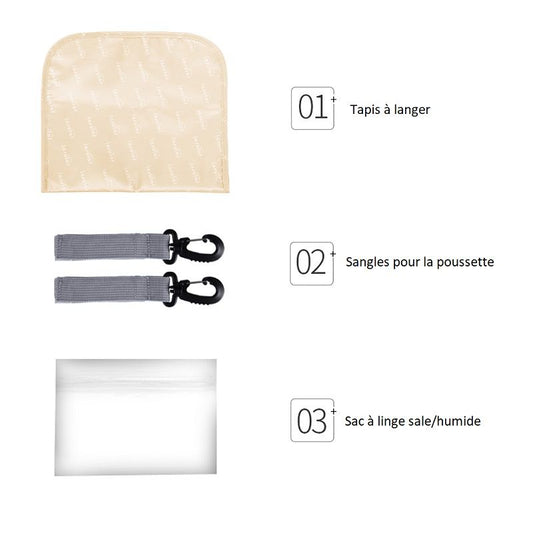Breastfeeding feels natural, but it can be very challenging, especially at first. Remember that line from Bryan Adams' song "Summer of '69": "I played it till my fingers bled..."? Unfortunately, breastfeeding for the first time can be like learning to play guitar. New moms' nipples often become sore, cracked, or even bleed. This can sometimes cause your baby to vomit if blood is swallowed. If you see blood when your baby spits up, don't panic: it's probably yours, not your baby's. At the hospital, nurses and lactation consultants will help you establish a good latch.
Quick tips to protect your breasts while breastfeeding:
1. Do not let your baby suckle unless he opens his mouth wide, like a big yawn. Otherwise, he may pinch the nipple, which can be extremely painful and damage the skin, potentially causing bleeding.
2. Vary positions to avoid trauma to your breasts. Don't hesitate to use a nipple shield if necessary.
3. Make sure the baby's tongue is well down before offering the breast. This step, often overlooked, is crucial.
4. If the baby tries to pull his head back after latching on, do not let him do so. It is important to keep the head against the breast to avoid damaging the nipple.
5. If you're having trouble getting a good latch, try placing your nipple on your baby's bottom lip. This will cause your baby to open his mouth wider, allowing more of the areola to be inserted into his mouth.
6. Practice with a breast pump before leaving the hospital. Remember that your baby receives all the benefits of breast milk whether it is expressed or taken directly from the breast. The method of administration does not matter.
7. If your baby has a tongue tie (ankyloglossia), consider consulting a pediatric ENT specialist. A small surgical procedure can free the tongue and make breastfeeding easier.
8. Seek help from lactation consultants and nurses at the hospital if you need it. These professionals can help you achieve breastfeeding success.
How to know if breastfeeding is going well
It can be difficult to know if your baby is breastfeeding well because the amount of milk taken in is not measurable. However, there are several signs that can indicate whether everything is going well or if difficulties are to be expected.
Signs that breastfeeding is going well:
1. Two to three days after giving birth, your breasts become engorged with milk.
2. Instead of crying constantly, your baby seems happy and satisfied after feedings. A baby who never seems satisfied and cries constantly is probably still hungry and may need a supplement.
After giving birth, a mother's breasts produce a small amount of colostrum. While this fluid is rich in antibodies to protect the baby from infections, it may not be enough to satisfy the baby, leading to frequent crying and frequent feedings. Although this can be exhausting, it can help stimulate milk production. Supplementing with a small amount of formula or using a pacifier can help prevent exhaustion.
3. The intervals between feedings are extended to two or three hours.
4. You hear your baby sucking and swallowing during feeding.
5. Your baby's mouth is full of milk after breastfeeding.
6. Your baby produces enough wet diapers, at least four to five in 24 hours.
7. Your baby does not appear to be yellowing (no yellow complexion).
8. Your baby is sometimes awake between feedings, although he sleeps a lot in the first few days, often more than 18 hours a day.
9. Your baby is gaining weight. Weight gain is the most objective sign that breastfeeding is going well. Be aware that some weight loss at the beginning is normal. It can take up to two weeks for a breastfed baby to return to his or her birth weight.
Signs that breastfeeding is not going well:
1. Your breasts never become engorged. If your milk does not come in, consult your pediatrician and obstetrician immediately.
2. Your baby is crying constantly, which may be a sign of dehydration requiring supplementation.
3. You don't hear your baby sucking or swallowing, or you don't see milk in his mouth.
4. Your baby is continuously losing weight.
5. Your baby seems lethargic and does not wake up spontaneously for feedings.
6. You can't remember the last time you changed a wet diaper.
7. Your baby constantly wants to nurse but never seems satisfied.
How to Maximize Your Breast Milk Supply
The most important factor in maximizing milk supply is to completely empty the breast. The more frequently the breast is emptied, the more milk supply will increase. If you are struggling to produce enough milk, a few simple steps can improve the situation.
After each feeding, use a breast pump to further empty the breast. Since an electric breast pump does not completely empty the ducts, hand expression can extract any remaining milk. You can repeat these steps at each feeding to maximize production.
Breastfeeding and vitamin supplementation
Although breast milk is the best food for your baby, it is low in two essential nutrients: vitamin D and iron. Iron supplementation is not necessary until four months of age, when iron stores acquired during pregnancy are depleted. However, vitamin D is essential from birth.
To prevent rickets, it is recommended to supplement breastfed infants with 400 IU of vitamin D per day. Concentrated drops can be applied to the breast or directly into the baby's mouth.
To learn more about breastfeeding, you can consult this article .























































